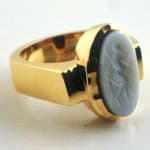Blue Agate Intaglio Depicting a Standing Deity, 18th Century CE
Agate/Gold
FJ.5999
The art of glyptic, or carving on colored precious stones, is probably one of the oldest known to humanity. Intaglios, gems with an incised design, were made as early as...
The art of glyptic, or carving on colored precious stones, is probably one of the oldest known to humanity. Intaglios, gems with an incised design, were made as early as the fourth and third millennia B.C. in Mesopotamia and the Aegean Islands. They display a virtuosity of execution that suggests an old and stable tradition rooted in the earliest centuries. The tools required for carving gems were simple: a wheel with a belt-drive and a set of drills. Abrasives were necessary since the minerals used were too hard for a metal edge. A special difficulty of engraving intaglios, aside from their miniature size, was that the master had to work with a mirror image in mind. The God Mercury was the protector of merchants, from which his name derives (the root “merx” meaning merchandise). After the Hyalinization of his cult, he was depicted as the messenger of Jupiter (Zeus), and as his servant in amorous exploits. Mercury's attributes are a broad-brimmed hat, winged sandals and a purse, symbol of profit. This intaglio shows Mercury striding forwards wearing his famous hat, with his right hand extended, holding what might be the copious purse. The pale blue of the agate gives a feeling of the open air and sky; of beautiful, virile gods strolling about the heavens, watching out for the humans below. This lovely ring exudes a feeling of happiness and warmth, perfect for someone who deserves the good things of life.



